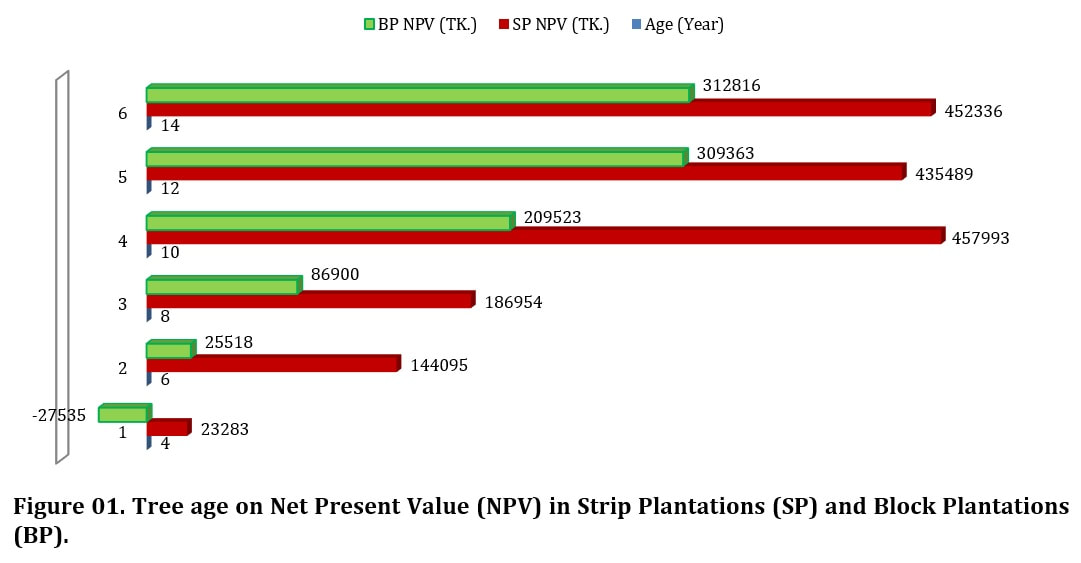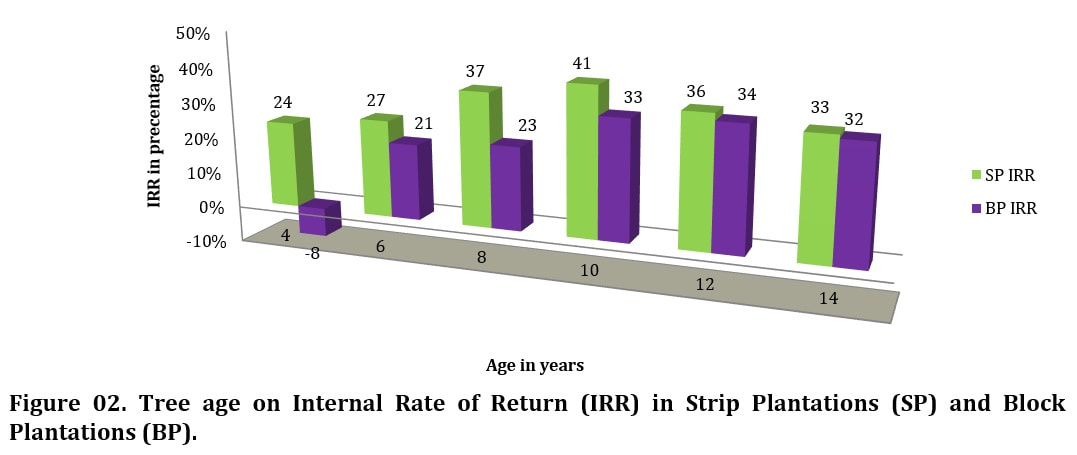J. Biosci. Agric. Res. | Volume 20, Issue 02, 1709-1716| https://doi.org/10.18801/jbar.200219.208
Article type: Research article|Received: 10.01.2019, Revised: 28.03.2019, Date of Publication: 30 April 2019.
Article type: Research article|Received: 10.01.2019, Revised: 28.03.2019, Date of Publication: 30 April 2019.
Optimal economic return and rotation period of large scale Acacia auriculiformis plantations in Bangladesh
Md. Rayhanur Rahman and Mohammed Kamal Hossain
Institute of Forestry and Environmental Sciences, University of Chittagong, Chittagong-4331, Bangladesh.
Institute of Forestry and Environmental Sciences, University of Chittagong, Chittagong-4331, Bangladesh.
Abstract
Acacia auriculiformis (Akashmoni) has shown excellent performance under plantations and appropriate for quick economic return even on soil of low fertility. The present study highlighted on the maximum economic return and rotation period in different age series of A. auriculiformis plantations at different locations of Chittagong during May 2017 to April 2018. At 13% discounting rate, the study revealed maximum NPV (457,993 Tk), IRR (48%), BCR (6.20), and Le (277,425 Tk) in 10 years old strip plantations. Besides, negative NPV (-27535 Tk), IRR (-8%), and Le (-16888 Tk) were found in 4 years old block plantations. Here, both the plantation practices are profitable (BCR>1.00) except only for 4 years block plantation (BCR=0.6). However, if we consider only NPV, the rotation period should be fixed at 10 years and 14 years for strip and block plantations respectively. Therefore, the study revealed, if we consider IRR, BCR, Le to determine rotation interval of A. auriculiformis in Bangladesh, it should be fixed at 10 years and 12 to 14 years of strip and block plantations respectively. Hence, a large amount of production losses every year as crook and lean formation takes place due to use of low quality seeds and planting materials. However, different management practices is also required immediately for large-scale plantation programs of different regions of the country.
Key Words: Acacia auriculiformis, Net present value, Internal rate of return, Land expectation value and Benefit cost ratio
Acacia auriculiformis (Akashmoni) has shown excellent performance under plantations and appropriate for quick economic return even on soil of low fertility. The present study highlighted on the maximum economic return and rotation period in different age series of A. auriculiformis plantations at different locations of Chittagong during May 2017 to April 2018. At 13% discounting rate, the study revealed maximum NPV (457,993 Tk), IRR (48%), BCR (6.20), and Le (277,425 Tk) in 10 years old strip plantations. Besides, negative NPV (-27535 Tk), IRR (-8%), and Le (-16888 Tk) were found in 4 years old block plantations. Here, both the plantation practices are profitable (BCR>1.00) except only for 4 years block plantation (BCR=0.6). However, if we consider only NPV, the rotation period should be fixed at 10 years and 14 years for strip and block plantations respectively. Therefore, the study revealed, if we consider IRR, BCR, Le to determine rotation interval of A. auriculiformis in Bangladesh, it should be fixed at 10 years and 12 to 14 years of strip and block plantations respectively. Hence, a large amount of production losses every year as crook and lean formation takes place due to use of low quality seeds and planting materials. However, different management practices is also required immediately for large-scale plantation programs of different regions of the country.
Key Words: Acacia auriculiformis, Net present value, Internal rate of return, Land expectation value and Benefit cost ratio
Article Full-Text PDF
| 208.02.20.19_optimal_economic_return_and_rotation_period_of_large_scale_acacia_auriculiformis_plantations_in_bangladesh.pdf | |
| File Size: | 964 kb |
| File Type: | |
Article Metrics
|
Share This Article
|
|
Article Citations
MLA
Rahman, M. R. and Hossain, M. K. “Optimal economic return and rotation period of large scale Acccia auriculiformic plantations in Bangladesh.” Journal of Bioscience and Agriculture Research 20 (02) (2019): 1709-1716.
APA
Rahman, M. R. and Hossain, M. K. (2019). Optimal economic return and rotation period of large-scale Acccia auriculiformic plantations in Bangladesh. Journal of Bioscience and Agriculture Research, 20 (02), 1709-1716.
Chicago
Rahman, M. R. and Hossain, M. K. “Optimal economic return and rotation period of large scale Acccia auriculiformic plantations in Bangladesh”. Journal of Bioscience and Agriculture Research 20 (02), (2019): 1709-1716.
Harvard
Rahman, M. R. and Hossain, M. K. 2019. Optimal economic return and rotation period of large-scale Acccia auriculiformic plantations in Bangladesh. Journal of Bioscience and Agriculture Research, 20 (02), pp. 1709-1716.
Vancouver
Rahman, M. R. and Hossain, M. K. Optimal economic return and rotation period of large-scale Acccia auriculiformic plantations in Bangladesh. Journal of Bioscience and Agriculture Research. 2019 April 20 (02): 1709-1716.
Rahman, M. R. and Hossain, M. K. “Optimal economic return and rotation period of large scale Acccia auriculiformic plantations in Bangladesh.” Journal of Bioscience and Agriculture Research 20 (02) (2019): 1709-1716.
APA
Rahman, M. R. and Hossain, M. K. (2019). Optimal economic return and rotation period of large-scale Acccia auriculiformic plantations in Bangladesh. Journal of Bioscience and Agriculture Research, 20 (02), 1709-1716.
Chicago
Rahman, M. R. and Hossain, M. K. “Optimal economic return and rotation period of large scale Acccia auriculiformic plantations in Bangladesh”. Journal of Bioscience and Agriculture Research 20 (02), (2019): 1709-1716.
Harvard
Rahman, M. R. and Hossain, M. K. 2019. Optimal economic return and rotation period of large-scale Acccia auriculiformic plantations in Bangladesh. Journal of Bioscience and Agriculture Research, 20 (02), pp. 1709-1716.
Vancouver
Rahman, M. R. and Hossain, M. K. Optimal economic return and rotation period of large-scale Acccia auriculiformic plantations in Bangladesh. Journal of Bioscience and Agriculture Research. 2019 April 20 (02): 1709-1716.
References
- Ang, L. H. (1994). Problems and prospects of afforestation on sandy tin tailings in Peninsular, Malaysia. Journal of Tropical Forestry Science, 7, 87-105.
- Banerjee, K. Khatua, D. C. and Mukherjee, N. (1993). Some new hosts of Cuscuta sp. Indian Forester, 119(9), 760-761.
- Belcher, B. M. (2005). Forest product markets, forests and poverty reduction. International Forestry Review, 7(2), 82–89. https://doi.org/10.1505/ifor.2005.7.2.82
- Das, D. K. and Alam, M. K. (2001). Trees of Bangladesh. Bangladesh Forest Research Institute, Chittagong. p. 342.
- Das, S. (1986). Nursery and plantation technique for Acacia auriculiformis, Bulletin 7, Silvicultural Research Division, Bangladesh Forest Research Institute, Chittagong. p. 28.
- Doran, J. C. and Turnbull, J. W. (1997). Australian trees and shrubs: species for land rehabilitation and farm planting in the tropics. Australian trees and shrubs: species for land rehabilitation and farm planting in the tropics. p. 384.
- Gittinger, J. P. (1974). Economic analysis of agricultural projects. Baltimore and London: The Johns Hoskins University Press.
- Gunter, J. E. and Haney, H. L. (1984). Essentials of forestry investment analysis. Instruction manual. ISBN 088 2460773. Library of Congress Catalog 83-063342.
- Hossain, M. K. (2015). Silviculture of Plantation Trees of Bangladesh. Arannayak Foundation. Dhaka, Bangladesh, p. 361.
- Islam, S. S. Islam, M. S. Hossain, M. A. T. and Alam, Z. (2013). Optimal Rotation Interval of Akashmoni (Acacia auriculiformis) Plantations in Bangladesh. Kasetsart Journal of Social Sciences 34, 181-190.
- Khemnark, C. (1994). Rehabilitation of degraded tropical forestland through agroforestry practices: A case study in Thailand. Journal of Tropical Forestry Science, 7(1), 128-135.
- Kibria, M. G. Sarkar, D. C. and Hossain, M. A. T. (2002). Economic Rotation of Akashmoni (Acacia auriculiformis) Plantations in Bangladesh, Forest Economics Division, Bangladesh Forest Research Institute (BFRI), Bangladesh (Unpublished).
- Latif, M. A. Islam, S. M. and Zahirul, M. J. (2001). Growth rate of Sissoo, Koroi, Akashmoni, Babla, Mahagony and Raintree planned on embankments and roadsides in the coastal areas of Bangladesh. Bangladesh Journal of Forest Science, 30(1), 52-57.
- Lee, E. W. S. Hau, B. C. H. and Corlett R. T. (2005). Natural regeneration in exotic tree plantations in Hong Kong. China Forest Ecology and Management, 212, 358-366. https://doi.org/10.1016/j.foreco.2005.03.057
- Muhammed, N. Hossain, M. K. and Miah, M. D. (2000). Growth performance of some plantation tree species in Madhupur Sal forest areas of Bangladesh. The Chittagong University Journal of Science, 24(1), 99-104.
- Muhammed, N. Koike, M. Chowdhury, M. S. H. and Haque, F. (2011). The Profitability of Strip Plantations: A Case Study on Two Social Forest Divisions in Bangladesh. Journal of Sustainable Forestry, 30, 1–23. https://doi.org/10.1080/10549811.2011.530568
- Pearse, P. H. (1967). The optimum forest rotation. The forestry Chronicle, 43(2), 178-195. https://doi.org/10.5558/tfc43178-2
- Petit, B. and Montagnini, F. (2004). Growth equations and rotation ages of ten native tree species in mixed and pure plantations in the humid Neotropics. Forest Ecology and Management, 199(2), 243-257. https://doi.org/10.1016/j.foreco.2004.05.039
- Rahman, M. R. Hossain, M. K. and Hossain, M. A. (2018). Growth performance and relationship among the growth parameters of Acacia auriculiformis in block, strip, and homestead plantations in Bangladesh. Bangladesh Agriculture, 8(1), 33-46.
- Salim, E. and Ullsten, O. (1999). Our Forests, Our Future. Report of the World Commission on Forests and Sustainable Development. Cambridge University Press.
- Sarkar, D. C. Das, S. and Kibria, M. G. (2008). Growth statistics of akashmoni (Acacia auriculiformis) in strip and block plantation of Bangladesh. Bangladesh Journal of Forest Science, 31(1 and 2), 43-50.
- Shepherd, A. (1994). The Christmas Island Rehabilitation Programme. Journal of Tropical Forestry Science, 7, 18-27.
- Singh, A. N, Raghubanshi, A. S. and Singh, J. S. (2002). Plantation as a tool for mine restoration. Current Science, 82(12), 1436-1441.
- Tradingeconomics, (2015). Lending Interest Rate (%) in Bangladesh. 30 June. Retrieved from https://tradingeconomics.com/bangladesh/lending-interest-rate-percent-wb-data.html.
- Turnbull, J. W. and Awang, K. (1997). Acacia auriculiformis A. Cunn. ex Benth. In: Faridah Hanum I, van der Maesen, L. J. G. (eds.). Plant Resources of South-East Asia No 11. Auxiliary plants. Leiden, the Netherlands: Backhuys Publishers, pp. 52-56.
- Wiersum, K. F. and Ramlan, A. (1982). Cultivation of Acacia auriculiformis in Java, Indonesia. Commonwealth Forestry Review, 61(2), 16-20.
© 2019 The Authors. This article is freely available for anyone to read, share, download, print, permitted for unrestricted use and build upon, provided that the original author(s) and publisher are given due credit. All Published articles are distributed under the Creative Commons Attribution 4.0 International License.
Journal of Bioscience and Agriculture Research EISSN 2312-7945.


